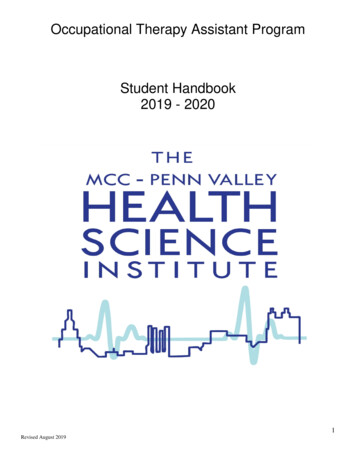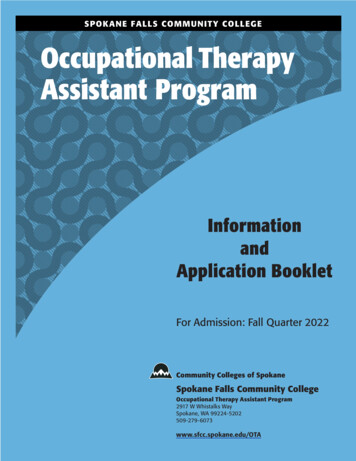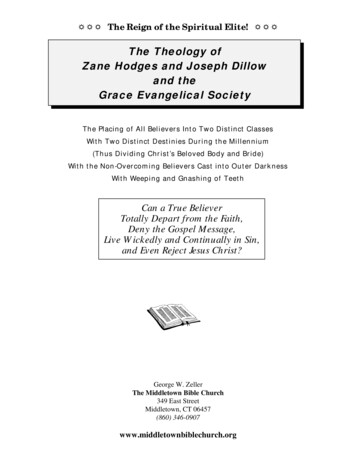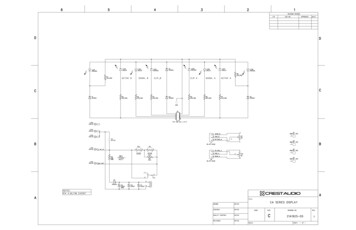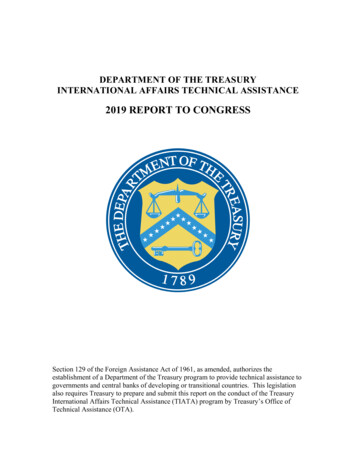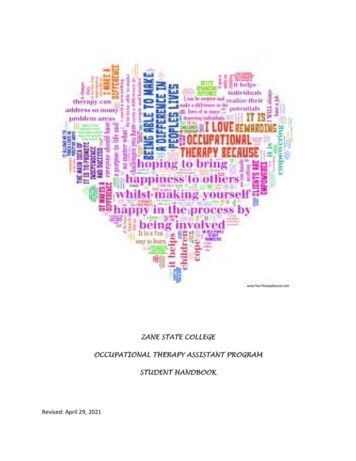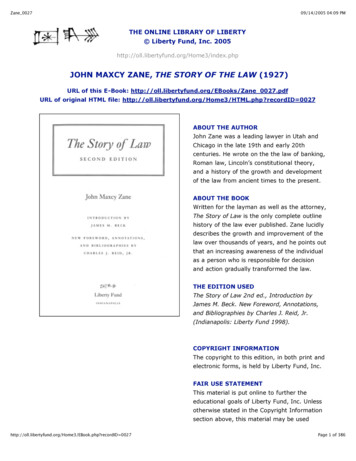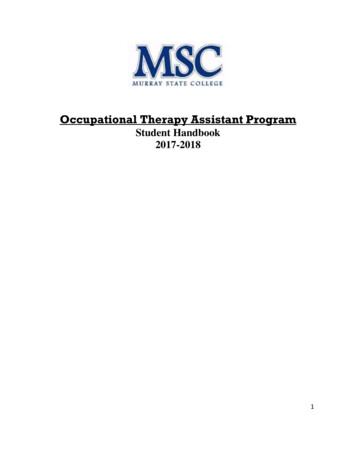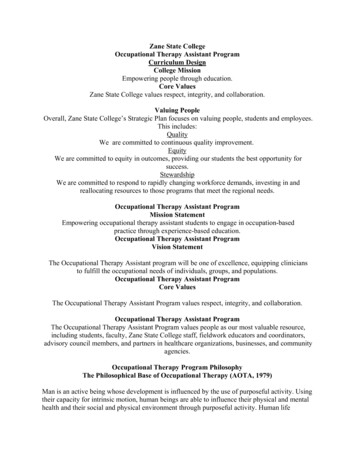
Transcription
Zane State CollegeOccupational Therapy Assistant ProgramCurriculum DesignCollege MissionEmpowering people through education.Core ValuesZane State College values respect, integrity, and collaboration.Valuing PeopleOverall, Zane State College’s Strategic Plan focuses on valuing people, students and employees.This includes:QualityWe are committed to continuous quality improvement.EquityWe are committed to equity in outcomes, providing our students the best opportunity forsuccess.StewardshipWe are committed to respond to rapidly changing workforce demands, investing in andreallocating resources to those programs that meet the regional needs.Occupational Therapy Assistant ProgramMission StatementEmpowering occupational therapy assistant students to engage in occupation-basedpractice through experience-based education.Occupational Therapy Assistant ProgramVision StatementThe Occupational Therapy Assistant program will be one of excellence, equipping cliniciansto fulfill the occupational needs of individuals, groups, and populations.Occupational Therapy Assistant ProgramCore ValuesThe Occupational Therapy Assistant Program values respect, integrity, and collaboration.Occupational Therapy Assistant ProgramThe Occupational Therapy Assistant Program values people as our most valuable resource,including students, faculty, Zane State College staff, fieldwork educators and coordinators,advisory council members, and partners in healthcare organizations, businesses, and communityagencies.Occupational Therapy Program PhilosophyThe Philosophical Base of Occupational Therapy (AOTA, 1979)Man is an active being whose development is influenced by the use of purposeful activity. Usingtheir capacity for intrinsic motion, human beings are able to influence their physical and mentalhealth and their social and physical environment through purposeful activity. Human life
includes a process of continuous adaptation. Adaptation is a change in function that promotessurvival and self-actualization. Biological, psychological, and environmental factors mayinterrupt the adaptation process at any time throughout the life cycle. Dysfunction may occurwhen adaptation is impaired. Purposeful activity facilitates the adaptive process.Occupational therapy is based on the belief that purposeful activity (occupation), including itsinterpersonal and environmental components, may be used to prevent and mediate dysfunction,and to elicit maximum adaptation. Activity, as used by the occupational therapist, includes bothan intrinsic and a therapeutic purpose.Zane State Occupational Therapy Assistant Program Philosophy1. Beliefs About Human BeingsOur program acknowledges these characteristics of human beings. They:A. Are occupational beings with intrinsic motivation driven by opportunities forautonomy and empowermentB. Are agents of change for self and othersC. Have an innate need to be social beings, connect, and communicate with othersD. Use their past experiences as the foundation for new learning and growthE. Learn and function best within a safe environment or context based on mutualrespectF. Are diverse2. How People Learn:In consideration of the above beliefs about human beings, we further believe that optimallearning is achieved through:A.B.C.D.E.F.Customization to one’s learning styleOccupation-based learningProgression from lower to higher order thinking (Bloom’s Taxonomy)Ongoing collaborationThe teaching of others including peer teachingEngagement in OT-related content for which learners are passionate3. Zane State OTA Program Philosophy of EducationA. Provide a safe learning environmentB. Provide positive role modelsC. Provide opportunities for:a. Engagement in life’s occupationsb.Critical thinkingc. Personal growthd.Professional developmente. Collaborative learning with1. Peers2. Instructors3. Staff4. Community
5. The worldf. Interpersonal skills building1. Communication2. Respect3. Tolerance4. EmpathyD. Provide formative feedbackE. Celebrate successesDefinitions of Practice Areas as Used Within Curriculum DesignThe curriculum is designed to prepare students for practice as a generalist and includes contentand exposure about both current practice areas as well as emerging practice areas. Zane StateCollege OTA Program uses the following definitions:Current practice settings - those areas where occupational therapists and occupational therapyassistants have been well established and recognized within occupational therapy literature for atleast 10 years and workplaces within our region for at least 5 years. The difference in number ofyears is because the Southeast Ohio region has been slower than average to accept andimplement emerging areas of practice. They may have been in existence in some regions formany more years than in our region.Emerging practice settings – areas where occupational therapy services have been offered andrecognized within occupational therapy literature within the immediate past 10 years andwithin workplaces within our region for 5 or fewer years. An emerging practice setting may alsobe a workplace in our region where occupational therapy services have never been provided,even if within occupational therapy literature evidence of effectiveness has been available formore than 10 years.Curriculum DesignThe OTA program at Zane State College bases its content, evidenced through course learningobjectives, on the Standards for an Accredited Educational Program for the OccupationalTherapy Assistant. The overall structure of individual courses, such as credit hours and lab andlecture components, and the general curriculum design are guided by the criteria established bythe Ohio Department of Higher Education.More specifically, the curriculum design is centered on Bloom’s Revised Taxonomy ofEducational Objectives (Anderson et al., 2001) with ascending levels of thinking skillsincluding; remembering, understanding, applying, analyzing, evaluating, and creating (seegraphic). This approach incorporates assumptions about students and learning that are inkeeping with the philosophy of occupational therapy education which include: Human beings are occupational by nature Learning occurs through doing and through scaffolding Challenges within learning must adapt and change as the student evolves within theireducation.
Bloom’s TaxonomyThe OTA curriculum design aligns with several of the assumptions of andragogy, or adultlearning theory, developed by Malcolm Knowles (Teaching Excellence in Adult Literacy[TEAL], 2011). Collaborative learning with respect for and integration of the students’ lifeexperiences into the learning process will be promoted (TEAL, 2011). Facilitation of thestudents’ active learning which incorporates problem-based experiences and learnerdirected choices will be provided (AOTA, 2015; TEAL, 2011). Finally, the OTA studentsare considered adult learners who are intrinsically motivated and prefer gaining knowledgethrough experiences that are relevant to their goals of becoming client-centered, occupationfocused occupational therapy assistants.The curriculum design also incorporates assumptions from the Mission and Core Values of ZaneState College which include: Students learn most effectively in an atmosphere of respect, integrity andcollaboration Education should be learner centered, collaborative, and occupation-based Education, although primarily intended to improve the student, also benefits thecommunity
The curriculum design is composed of five threads which are:1) Occupation is OT’s Distinct Value2) Occupational Performance Throughout the Lifespan3) Critical Thinking4) Diversity5) Leadership and Advocacy.Each thread is introduced in topics within the first semester of the program, and is reviewed anddeveloped in increasing complexity, building on Bloom’s Taxonomy, throughout the program.Occupation is OT’s Distinct ValueOccupations are a substantial part of occupational therapy’s rich history in facilitating clients’abilities to perform their valued daily activities and achieve their performance goals. The use ofoccupation-based assessments and interventions are vital to attaining the therapeutic benefits ofOT in today’s healthcare environment (Lamb, 2017). By employing occupations as the tools forOT treatment as well as the desired outcomes of client-centered intervention, OT represents itsdistinct value to those served, which sets it apart from other allied health professions (AOTA,2014; Lamb, 2017). The concept of occupation as the foundation of occupational therapy and itsvalue in facilitating an individual's function and health is introduced in the first-semester OTAPcourses and integrated into all subsequent classes. An emphasis is placed on developing thestudent’s ability to analyze occupations and activities as well as develop client-centered,occupation-based interventions for case-based and clinical practice experiences. The learners aresupported with graded scaffolding to practice these skills, addressing the function and areas ofneed of clients throughout the lifespan as they progress through the OTAP curriculum.Occupational Performance Throughout the LifespanThe Occupational Therapy Assistant Program at Zane State College stands poised to preparestudents to serve the diverse needs of the population through the development of OccupationalPerformance Throughout the Lifespan thread of content during our program. Our OccupationalPerformance Throughout the Lifespan thread incorporates evidence-based study of the physical,cognitive, sensory, spiritual and psychosocial needs of all ages to engage in occupations.Knowledge acquired is directly applied through OT skills that maintain health and wellness ofthe population. This maintains optimal performance of activities of daily living and instrumentalactivities of daily living for independent functioning of the clients served. Our program supportsthis goal through collaborative learning experiences with a variety of fieldwork placements.Critical ThinkingThe faculty of the OTA Program at Zane State College feels strongly that critical thinking is animportant part of the foundation knowledge required for occupation-based practice. Because ourgraduates work primarily in this largely rural region, many are expected to function in theircareer with limited interaction with the supervising occupational therapist. Skilled criticalthinking forms the basis for attaining the following expectations:A. The occupational therapy assistant program recognizes the value of and emphasizes thedevelopment of critical thinking as a theme that is woven throughout the program.1.From the first investigative contact that a potential student has with thefaculty of the OTA program, critical thinking is identified as a vital asset and skillof an occupational therapy assistant.
2.The concept of problem-solving and analysis based on critical thinking isintroduced in the first semester of the OTA curriculum through didacticclassroom and laboratory learning. An example is a course assignment, tocomplete an occupational analysis of a daily living skill/task.3.Each course in the curriculum requires the student to employ criticalthinking multiple times and at various levels, from classroom discussion tocapstone projects.B. Based on the AOTA Vision 2025, occupational therapy uses critical thinking to find“effective solutions that facilitate participation in everyday living.” (AOTA, 2018).C. Critical thinking must be a strong skill for occupational therapy practitioners to besuccessful. These professionals utilize this vital ability to respond to the dynamic demands ofworking with diverse populations in traditional and non-traditional practice settings. Theymust think on their feet and react to changing patient conditions. Equally important, theymust be critical in their appraisal of evidence to support their clinical decisions.DiversityZane State College is located in Southeast, Ohio, and is the beginning of the Appalachian region.This area is considered part of “central Appalachia”, a political, cultural, and bioregionalclassification that includes southeastern Ohio, eastern Kentucky, and most of West Virginia.Often the students in the OTA Program from this area have not traveled significantly outside theregion, and the region has comparably little diversity. Intentionally incorporating larger worldviews is of importance to position students to work in a globally diverse workforce with globallydiverse clients.Based on the AOTA Vision 2025, “occupational therapy maximizes health, well-being, andquality of life for all people, populations, and communities that facilitate participation ineveryday living.” (AOTA, 2018).The OTA program makes specific and continuous efforts toprovide a learning context in which respect for all persons and understanding of diversity arepracticed (including age, class, color, disability, ethnicity, family structure, gender, maritalstatus, national origin, race, religion, sex, and sexual orientation). The program strivesto maintain equity in access and reflect diversity in the learning environment through classroomlectures and activities, selection of clinical education settings, composition of the advisorycommittee, use of educational resources including speakers, and the composition of its faculty.Leadership and AdvocacyThe OTA Program at Zane State College identifies Leadership and Advocacy as a thread fortheir program because of the following reasons: OTA Program Director and Faculty are service oriented and strongly associatedwith state and national professional organizations. Their examples promoteleadership to the students and modeling should be optimized throughout the program,along with opportunities for students to practice/demonstrate these skills.The profession of occupational therapy is at a crucial time in its existence and theneed for professional involvement is great. Students are mentored to be part of thenecessary voice while in the program. This spirit of involvement will serve both
them and the profession once the students graduate and become practicing clinicians.Because support for leadership and advocacy are so apparent in the fabric of theinstitution, a thread within the OTA program flows easily. Zane State Collegesupports leadership and advocacy through funding of employee travel, release timefor volunteerism, and the hosting of professional meetings and conferences. The OTA program views leadership and advocacy as being part of the ethicalresponsibilities of being an OT practitioner, and therefore expects that students willact as leaders and advocates, to the level of their ability, throughout the program andas a lifelong characteristic.The tools and role models for being leaders and advocates will be made available throughout theprogram, and to alumni through opportunities such as continuing education, fieldworksupervision and the College website.Student OutcomesThe threads of the curriculum, as experienced through coursework and fieldwork, lead to theaccomplishment of the following student outcomes:An entry-level practitioner with an associate of applied science degree in Occupational TherapyAssistant Technology from Zane State College will be able to:A. Apply foundational knowledge of occupational therapy theory, principles, andtherapeutic use of occupations to achieve expected outcomes as related to occupation. B. Apply evidence-based occupational therapy interventions, addressing the holistic aspectsof performance in a variety of contexts and environments to support engagementof diverse clients in everyday life activities that affect health, well-being, and quality of life.Collaborate effectively with occupational therapists (OTs) and demonstrate understanding of theroles and responsibilities of OTs and OTAs in service delivery and the supervisory process.C. Apply critical thinking and clinical reasoning skills to create interventions, gradations,and adaptations that overcome barriers and promote the clients’ participation in meaningfuloccupations in varied settings.D. Integrate effective oral and written communication into advocating for the professionand its recipients, representing occupation-based OT services, and facilitating therapeuticinteractions with clients and families, as well as interprofessional collaboration.E. Integrate ethical and professional behaviors into all interactions as an OTpractitioner and incorporate leadership and lifelong learning into continued professionaldevelopment.Curriculum Sequence and Review of ContentNote that following the description of the course and rationale for placement in thesequence is a listing (in parentheses) of curriculum threads within the course and [inbrackets] the Bloom’s Taxonomy levels accomplished within the courseYear One:Summer Session (1)
BIOL 2400 Anatomy and Physiology I lecture and BIOL 2410 Anatomy and Physiology Ilaboratory—In these courses students learn the human anatomy and physiologyof cells, tissue, with an emphasis on the musculoskeletal and integumentary systems. Content iscovered in lecture and further explored via laboratory experiences. This course is placed early inthe sequence for application in the OTA courses, along with medical terminology so thatstudents are able to apply their knowledge to the content of the course. [Remembering,Understanding]ENGL 1500 Composition I —Emphasizing the writing and revising process with essay masteryas the primary goal, this course develops solid use of language and writtencommunication. While this is important in all courses, it is especially relevant in acommunication-rich field like occupational therapy. Success in this foundational writing courseprepares students for the many writing tasks in their academic career and prepares themfor clinical documentation requirements. [Remembering, Understanding, Applying,early Analyzing]FYEX 1010 First-Year Success Strategies — This is a college readiness and orientation courserequired in the first quarter for all curricula. The content informs students about the policies andstructure of the College. It also emphasizes topics of importance for college success.These include time management, financial management, learning styles, career exploration,communication, and problem solving. (Critical Thinking, Diversity) [Remembering,Understanding]HLTH 1210 Medical Terminology — This foundation in the language of healthcare isimportant for all future OTA courses and for many of the general courses such as Anatomyand Physiology. The placement of this memorization-based course at the beginning is in keepingwith Bloom’s taxonomy. The placement also acts to prepare students for the consistency ofstudy, repetition, and devotion of time that will be critical for success in this rigorous associatedegree program. Students in OTAP 1070 and OTAP 1130 use what they are learned in themedical terminology course when they study the terminology of the OT profession in the nextterm. [Remembering, Understanding]PSYC 1010 Introduction to Psychology—a subsequent psychosocial OTAP course,Introduction to Psychology is taken relatively early in the curriculum. PSYC 1010 has noprerequisite courses. However, since it includes writing assignments, it is helpful that OTAstudents are studying college-level English concurrently. Placement here also has PSYC 1010 inthe semester immediately preceding OTAP 1070 – Foundations of Occupational Therapy, inwhich they learn the history of OT including its foundation in mental health. Thisprovides students optimal opportunity to directly connect related content. (OccupationalPerformance Throughout the Lifespan , Diversity) [Remembering, Understanding]Fall Semester (Semester 1)BIOL 2420, Anatomy and Physiology II Lecture and BIOL 2430, Anatomy and PhysiologyLaboratory II - These courses are the second half of the Anatomy and Physiologyseries. Topics covered complete the comprehensive review of human anatomy and physiology.Students take these courses as prerequisites to the first OTAP physical dysfunction course(OTAP 2170) and their Level I Fieldwork experience (OTAP 1302). Within the first anatomyand physiology course students learned about the muscles and bones, which are the structuresmost needed for content covered in OTAP 2170. The level I fieldwork experience affordsstudents the opportunity to see examples of content from both the anatomy and physiologycourses and from OTAP 2170 and 1520 (Mental Health Concepts and Techniques for OTA),
thus providing for an opportunity to begin to synthesize information for use in OTAP courses.[Remembering, Understanding]HLTH 1730, Disease and Disease Process-Covering basic pathophysiology,this course introduces students to the most common diseases and diagnoses encountered byhealth students and the effect they have on the human body. When taken concurrently withAnatomy and Physiology II, students are able to connect the normal to the abnormal based ontheir existing and newly-learned knowledge. Of equal importance, this courseis completed before the physical dysfunction OTAP course is taken. The physical dysfunctioncourse emphasizes techniques and how they apply to diagnoses, to develop the occupationaltherapy approach to treatment or management. [Remembering, Understanding]OTAP 1070– Fundamentals of Occupational Therapy — OTAP 1070 builds the foundationfor all other learning in the OTA courses. It begins with an introduction to occupational therapydefinition and practice and the history of the occupational therapy profession. As part ofthis introduction students complete a personality inventory and begin to make connectionsbetween their personality and the profession, to understand differences in learning styles, and theconcept of therapeutic use of self. The course then moves on to review the roles and functions ofthe OTA and OT and the supervisory relationship, again relating learning styles to thiscollaborative relationship. From here the topics proceed to an overview of occupational therapyincluding: practice settings, professional associations, areas of practice, theoretical base for OT,human development, occupation and occupational performance, activity analysis, OT practiceframework, terminology, OT frames of reference, credentialing, ethics, professional behaviorand development and documentation. Every subject from this course is developed further and ingreater detail in future courses. (OT’s Distinct Value, Occupational Performance Throughoutthe Lifespan , Critical Thinking, Diversity, and Leadership andAdvocacy) [Remembering, Understanding , early Applying]OTAP 1130 Fundamentals of Occupation and Occupational Analysis— This course focuseson the Occupational Therapy Practice Framework: Domain and Process, Third Edition (AOTA2014) and using it to perform activity/occupational analysis. Students learn a variety of mediaand do occupational analyses (whole or in part) of at least three occupations. These include: art,woodworking, leather craft, general craft media, sewing and needlecraft, ADLs and adaptiveequipment, games and sports and computer media. Students also initiate analysis of basic casestudies as a first application effort. (OT’s Distinct Value, Occupational Performance Throughoutthe Lifespan , Critical Thinking, Diversity) [Remembering,Understanding, Applying, Analyzing]SOCI 1010, Introduction to Sociology- Topics, in this course, expose students to the basicconcepts, theories, perspectives, and processes in sociology. These include culture, socialization,groups, organizations, social deviance, social class and inequality, social change and socialinstitutions. This material helps students to better understand themselves and their relationship tothe larger society. This is important for the well-rounded education of OTA graduates and thedevelopment of their ability to work within a globally connected and diverse workforce.(Occupational Performance Throughout the Lifespan , Diversity) [Remembering,Understanding, Applying, Analyzing]Spring Semester (Semester 2)COMM 1220 or COMM 2610 – Communication Elective – One Communications course isrequired in all curricula at the College. It is an introduction to interpersonal communication
or public speaking processes designed to help individuals communicate effectively in a variety ofsituations. In COMM 2610 - Public Speaking, the emphasis is on developing, organizing,preparing, delivering and analyzing public presentations. While COMM 1220, explores theprinciples of communication as it pertains to personal and workplace relationships. Perception,culture, listening, and conflict management are among the topics. Each of these courses providethe OTA students the opportunity to gain knowledge of effective communication methods thatfacilitate their success in didactic and directed practice learningenvironments. (Critical Thinking, Diversity, Leadership andAdvocacy) [Remembering, Understanding , Applying, Analyzing ]ENGL 2500—Composition II or ENGL 2800--Technical Writing— This is the elective forthe second course in the writing curriculum. It strengthens students’ composition skills andintroduces them to workplace writing including technical description, layout and design, reports,summaries, graphics, memos, letters, and job search. Students can apply their learning from theirEnglish elective immediately in OTAP 1302 regarding the mechanics of clinical documentation.[Remembering, Understanding , Applying, Analyzing]OTAP 1302 Directed Practice in Physical Dysfunction and Mental Health (Level IFieldwork)—This course is composed of online discussions and assignments and an average of5 hours per week spent at a clinical site. The topics coordinate with the professional developmentthat students are experiencing during their fieldwork hours. The primary purpose of level Ifieldwork is to develop and use therapeutic use of self, communication, and observation skillswithin a clinical setting. Students may be assigned to OT or non-OT settings, all of which serveindividuals with developmental or disabling conditions that could be treated by occupationaltherapy via an OTA. At this point in the curriculum sequence, students know about occupationaltherapy and the OT Practice Framework and can do basic criticalthinking about appropriateness of fit for intervention, occupational appropriateness of activities,adaptation and gradation. During fieldwork hours they begin to see the effects of disease andhow OT interventions are used to minimize those effects and improve function. (OT’s DistinctValue, Occupational Performance Throughout the Lifespan , Critical Thinking, Diversity,Leadership and Advocacy) [Remembering, Understanding , Applying, Analyzing ,early Evaluating]OTAP 1520, Psychosocial Concepts & Techniques for Occupational Therapy Assistant(OTA) -By providing OTA students with an introduction to the etiology and symptomatology ofpsychosocial dysfunctions, they gain an understanding of the residual cognitive, psychological,and/or social effects of the conditions and the implications for intervention. Appropriateoccupational therapy treatment techniques and documentation are emphasized. This course isplaced at this point in the sequence because the first two terms of the program focused on generaltechniques and information, while this course addresses specific diagnoses and their impacton an individual’s psychosocial functioning. Expectations of student performance continue toadvance along Bloom’s taxonomy with greater analysis and evaluation of contentrequired. (OT’s Distinct Value, Occupational Performance Throughoutthe Lifespan , Critical Thinking, Diversity, Leadership and Advocacy) [Remembering,Understanding, Applying, Analyzing, Evaluating, Creating]OTAP 2170 – Physical Dysfunction in Occupational Therapy - The understanding of physicaldysfunction and treatment planning within occupationaltherapy, emphasizing understanding of general treatment and supportive concepts utilized for
various physical dysfunctions. The student explores the underlying musculoskeletal andneuromuscular systems and learns the associated therapeutic modalities for treatment. Thetreatment planning process and implementation are incorporated with documentationskills. Physical dysfunction within occupational therapy is covered at this point in the curriculumbecause the students have already taken most of the preparatory courses (Psychology,Sociology, Medical Terminology, Anatomy & Physiology I & II). Also, the majority of Level IFieldwork sites address physical dysfunction needs. This provides the opportunity for students tovisualize and apply what they are learning in the classroom during theirfieldwork experience. (OT’s Distinct Value, Occupational Performance Throughoutthe Lifespan , Critical Thinking, Diversity) [Remembering,Understanding, Applying, Analyzing, Evaluating, Creating]Second Year:Fall Semester (Semester 3)OTAP 2100, Physical Agent Modalities for Occupational Therapy-This course offers anintroduction to the use of thermal, mechanical, and electrotherapeutic modalities as a preparatorymethod to facilitate occupational performance of individuals. Safe and effective use of thesemodalities is emphasized to implement the intervention plan to achieve client-centered,occupation-based goals. This course was placed in the semester following the physicaldysfunction course in order to allow students to have a foundation in the topic of physicalfunctioning and intervention on which to build. (Critical Thinking, Leadership andAdvocacy) [Remembering, Understanding, Applying, Evaluating, Creating]OTAP 2210, Occupational Therapy in Geriatric and Alternative Practice Settings-Using theapproach of category specific content, this course provides students with an introduction to therole of occupational therapy with the elderly population. Emphasis is on understanding the agingprocess and function pertinent to seniors and the implications for treatment modalityselection specific to this popul
The Occupational Therapy Assistant Program values people as our most valuable resource, including students, faculty, Zane State College staff, fieldwork educators and coordinators, advisory council members, and partners in healthcare organizations, businesses, and community
